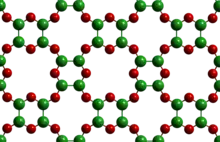 | |
| Names | |
|---|---|
| IUPAC name
oxoboron | |
| Identifiers | |
3D model (JSmol) |
|
PubChem CID |
|
| |
| Properties | |
| BO | |
| Molar mass | 26.81 g/mol |
| Appearance | white powder |
Except where otherwise noted, data are given for materials in their standard state (at 25 °C [77 °F], 100 kPa).
Infobox references | |
Boron monoxide (BO) is a binary compound of boron and oxygen. It has a molar mass of 26.81 g/mol. The material was first reported in 1940,[1] with a modified synthetic procedure published in 1955,[2] however, the material's structure had remained unknown for nearly a century. A number of allotropes of BO have been theorized ranging from molecular species, to 1D, 2D, and 3D-structured materials,[3][4][5] but these were difficult to differentiate using common structural characterization methods. Recent work suggests that the material forms 2D nanosheets composed of O-bridged B4O2 rings, a structure initially postulated in 1961.[6][7] Due to the lack of precise structural information on the identity of the compound, it has not found widespread use in industry.
Synthesis
Boron monoxide is typically produced through the condensation of tetrahydroxydiboron (chemical formula; B2(OH)4) at temperatures of 200–500°C.[2] The use of higher temperatures (700°C) leads to the formation of hard B2O3 glasses. These glasses generally have a dark appearance, from the dissolved elemental boron, and are also produced directly through the dissolution of B into B2O3.[1]
BO has been used in the synthesis of B2Cl4,[6] which served as the only evidence, until 2010,[3] of the preservation of the B–B bond present in the precursor compound.
See also
References
- 1 2 Zintl, E.; Morawietz, W.; Gastinger, E. (1940-10-03). "Bormonoxyd". Zeitschrift für anorganische und allgemeine Chemie (in German). 245 (1): 8–11. doi:10.1002/zaac.19402450102. ISSN 0863-1786.
- 1 2 Wartik, Thomas; Apple, Eugene F. (1955-12-01). "A NEW MODIFICATION OF BORON MONOXIDE". Journal of the American Chemical Society. 77 (23): 6400–6401. doi:10.1021/ja01628a116. ISSN 0002-7863.
- 1 2 Claeyssens, Frederik; Allan, Neil L.; Norman, Nicholas C.; Russell, Christopher A. (2010-09-30). "Design of three-dimensional solid-state boron oxide networks: Ab initio calculations using density functional theory". Physical Review B. 82 (9): 094119. doi:10.1103/PhysRevB.82.094119.
- ↑ Li, Da-Zhi; Bai, Hui; Chen, Qiang; Lu, Haigang; Zhai, Hua-Jin; Li, Si-Dian (2013-06-28). "Perfectly planar boronyl boroxine D3h B6O6: A boron oxide analog of boroxine and benzene". The Journal of Chemical Physics. 138 (24): 244304. doi:10.1063/1.4811330. ISSN 0021-9606.
- ↑ Liu, Y.; Liu, C.; Pu, L.; Zhang, Z.; King, R. B. (2017-03-14). "Boron monoxide dimer as a building block for boroxine based buckyballs and related cages: a theoretical study". Chemical Communications. 53 (22): 3239–3241. doi:10.1039/C6CC09489A. ISSN 1364-548X.
- 1 2 McCloskey, A. L.; Brotherton, R. J.; Boone, J. L. (December 1961). "The Preparation of Boron Monoxide and its Conversion to Diboron Tetrachloride1". Journal of the American Chemical Society. 83 (23): 4750–4754. doi:10.1021/ja01484a015. ISSN 0002-7863.
- ↑ Perras, Frédéric A. (June 28, 2023). "The Structure of Boron Monoxide". J. Am. Chem. Soc. doi:10.1021/jacs.3c02070 – via ACS Publications.